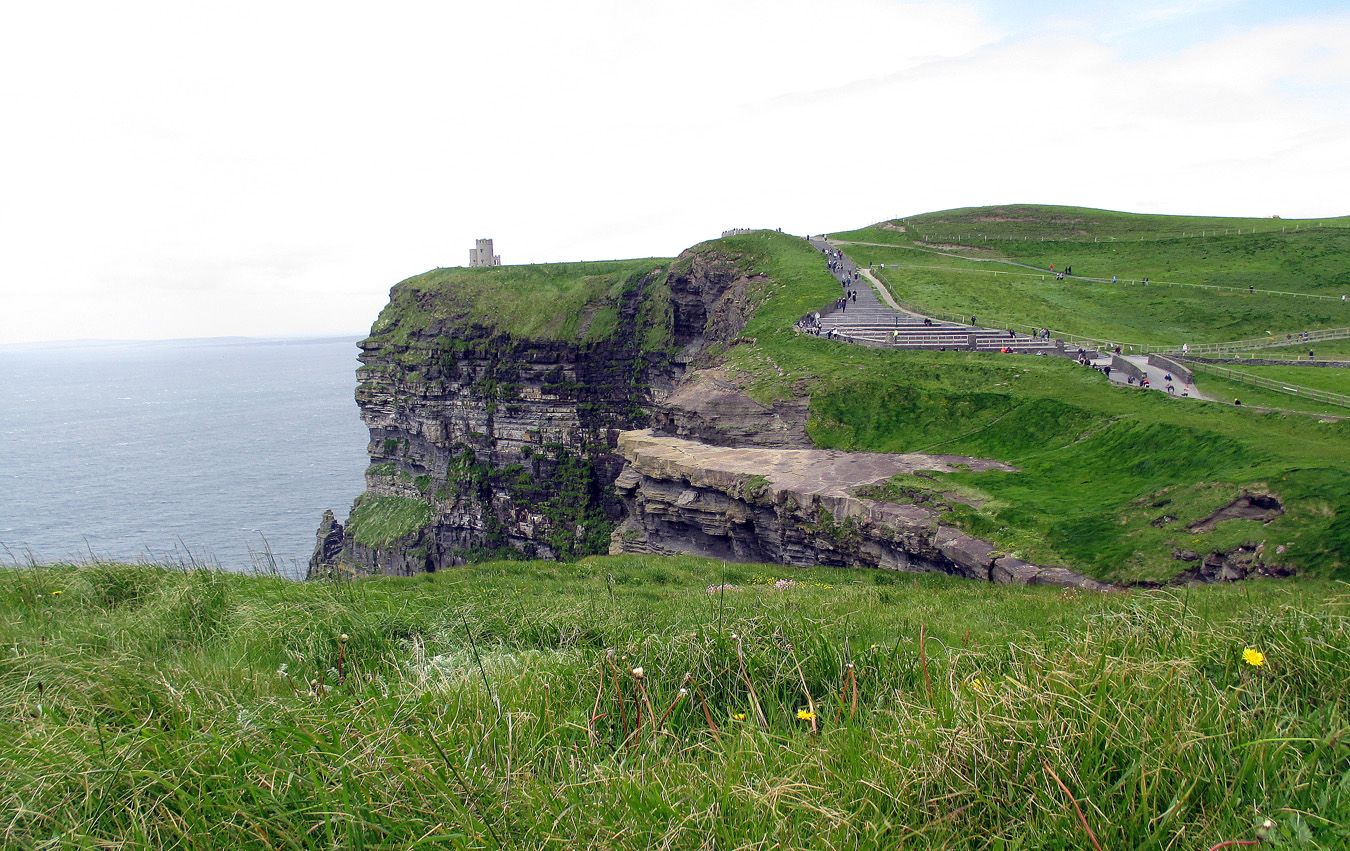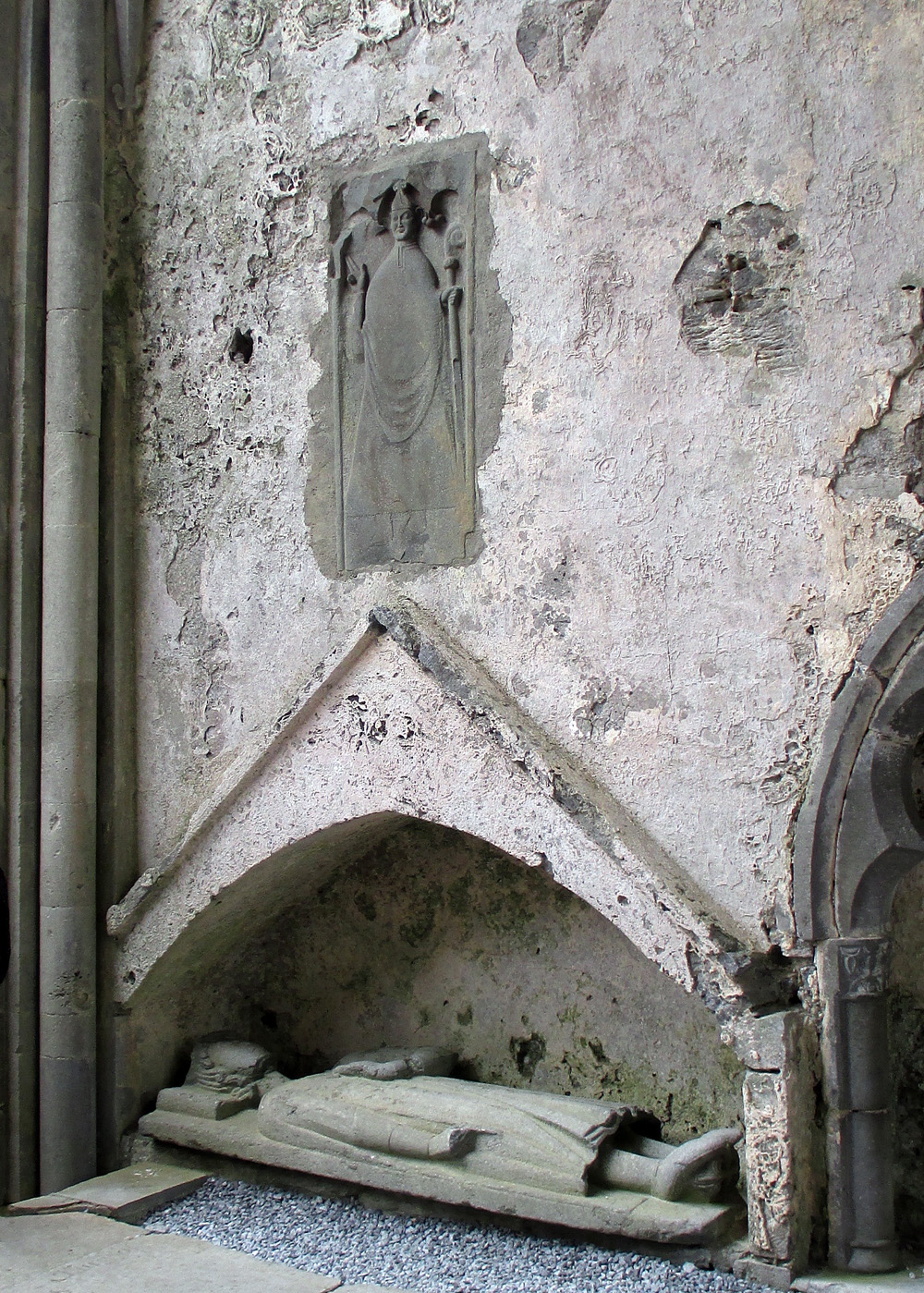We got off to a very slow start because, as I understood it, a driver did not show up to lead a tour. Those of you have read my earlier posts in this series may remember that tour companies run two or three different tours on the same day, and pick people up at hotels distant from the official tour meeting point, Galway's new coach station. This morning three tours were departing, and in addition to the passengers being confused, so were the drivers. All was resolved eventually, and those of us on the coach originally scheduled for Connemara were able to remain on it, led/driven by a fellow named Cam, who began the day thinking he was to guide the tour to the Cliffs of Moher.
I'm not sure if it was because of his confusion, or if he was better at the tour of the cliffs than he was at the Connemara mountains tour, but Cam was the least prepared and least informed guide I experienced on my travels in Ireland. When we began, a half hour later than expected, he spoke to us about the subjugation of the Irish, a theme that would continue as the tour progressed (and rightly so), but his chronology often fell out of order, allowing Henry VIII to live for nearly 200 years and adding about 50 years to the life of Oliver Cromwell. Gradually, however, Cam seemed to recover from his confusion and warmed to his subject, so the tour ended much better than it began.
 |
| Ross Errilly Friary |
Even if a mute had been guiding us, we were driven into some really beautiful, relatively unspoiled country. We made our first stop in the lowlands, at another ruined friary named Ross Errilly. Founded in 1351 by the Franciscan order, the abbey was substantially rebuilt and enlarged in 1498. Although the monks were expelled several times throughout the abbey's existence the Franciscans can be a stubborn lot, and managed to hold onto it until the mid eighteenth century, when they left and the buildings began to fall into ruin.
The locals usually call the friary Ross Abbey, but as the place never had an abbot as the Franciscans were less inclined to leaders than other orders, a friary it is. And the most extensive, best preserved of all the Franciscan friaries in Ireland.
 |
| Ireland insists on greenery everywhere, even on ruined friaries! |
 |
| Shorn sheep and lambs in the field next to the friary |
One of the most interesting things about Ross Errilly was not the friary itself (though it enchanted Dottore Gianni) but an
 |
| One big bag of shearings |
 |
| One of several pleasing streams that surround the village of Cong |
On then from the friary to other sights. The next was a village with the odd name of Cong (odd at least to Dottore Gianni) that is charming to visit for its own sake, but there are many such villages in this beautiful area. This one has the distinction, exciting to some, dubious to others, of being the place where a movie from the early 1950s by one of America's great directors, John Ford, was filmed. It is named The Quiet Man, and stars John Wayne and Maureen O'Hara, closely supported by Victor McLaglen and Barry Fitzgerald.
 |
| When you read my synopsis below you'll know more than you ever wanted to about the film, and after the synopsis, a few interesting things about Cong other than the film! |
Briefly, the film concerns an American (Wayne - who couldn't do an Irish accent in any case - he always played himself) who returns to Ireland to claim his family's property. The "villain" (McLaglen) covets the land for himself. He happens to have
 |
| The bar featured in the film is alive & kicking! |
As Cam reminded us, Americans LOVE The Quiet Man, the Irish not so much, as it engages in embarrassing stereotypes (particularly in Barry Fitzgerald's performance of the drunken stage Irishman). But whether or not every person in
 |
| The Quiet Man Cottage Museum |
 |
| The Qiuiet Man statue |
Let's look at other reasons to like Cong. Dottore Gianni discovered that the word cong comes from conga (still doesn't sound very Irish to him) which means a narrows. Though you wouldn't know it, town is actually surrounded by water, on
 |
| Market Cross, Cong |
 |
| Another lovely waterway in Cong |
I most like that a fellow named Sir William Wilde was born in Cong. Actually I don't give a tinker's damn about William himself, but he sired a son named Oscar, who spent long periods of time in Cong and about whom I do care if for nothing else than his great play The Importance of Being Earnest. I played the title role in that comedy of manners once a long time ago, and Dottore Gianni tells me that I was VERY good in it!
 |
| There is so much water in and around Cong that this house exploited it - if you look at the glassed part of the place on the left, you'll see the water running under it |
But there is also one more person who must be mentioned, a certain evil landowner named Captain Boycott. The great Irish nationalist hero Charles Stuart Parnell advocated that the common people of Ireland should not try to fight the British on the field of battle, as they'd surely lose. Instead they should use stealth and cleverness. A great example of this is what happened to Captain Boycott of Cong. Because he was a cruel landlord that nobody liked, little by little people began to "boycott" him. His workers left the fields, merchants in town did not bring him supplies, even his household staff up and left. Captain Boycott, furious at all this but powerless to stop it, up and left himself, and was never seen again. And that is the origin of the word boycott!
So don't ya go telling me (or Dottore Gianni) that Cong is famous only for The Quiet Man!
Our guide Cam could not let us off the coach but did stop it for a few minutes to tell us about "famine cottages" - these were small abodes built of stone with roofs of thatch or turf (the Irish term for peat - more about that soon). Large families, mostly tenant farmers, inhabited these nearly unlivable houses, but in the mid-nineteenth century potato famine many were evicted or burned out of these shabby places by their British landlords for non-payment of rent. This was a horrible time for the Irish. Their alternatives were to emigrate, and many did, but in "coffin ships" on which so many were stuffed together, sometimes never seeing the sky in the journey across the Atlantic, that as many one-third of this human cargo would die on the journey; or to die of starvation, and many did. It is estimated that one million Irish died during this time, and a million more emigrated.
But except for potatoes there was no famine! Crops were steadily exported from Ireland at this time, and landlords had plenty of grain - they just didn't give it to the Irish - they either kept food for themselves or sent it out into the rest of the world to make money from it. All the Irish got were potatoes, and when the potato crops began to fail it was their tough luck. The landlords thought the Irish were lazy good-for-nothings - and Catholics! Worse yet. And they treated the Irish as sub-human. It's a nightmare of a story, one that I heard in several versions throughout my time in Ireland, and while I knew about the famine beforehand I had no idea how desperate the situation was.
 |
| Heading through the mountains one of many, many beautiful views |
 |
| Add a sheep and her lamb and you get bucolic bliss! |
On we drove, into the mountains this time, and the scenery became more and more breathtaking as we went. We stopped a few times for photos, once at a lake, once at Killary, Ireland's only fjord. It's a beautiful sight, and we happened to see the tour boat ploughing through the waters, next to mussel beds - the Irish like their mussels!
 |
| The Killary Fjord |
 |
| The cruise boat on the fjord - not a bad way to see it! Note the mussel fields in the water |
Then farther up still, and another stop that overwhelmed me, even if my photos cannot capture it adequately.
 |
| The higher one climbs, the more dramatic the landscape becomes |
 |
| Can you count 40 shades of green here? I think I can. 49 shades of green refers to a Johnny Cash song, written after he toured Ireland |
 |
| Or if not in the phot above, how about here? |
 |
| An old ham poses with that beautiful view in the background |
Beyond that, almost to Kylemore Abbey now, we drove through Leenane (I always thought it was pronounced Leh-NANE as in main - Cam pronounced it LEE-nan as in Ann), a place I was very curious to see because it is the setting for a play by Irish writer Martin McDonagh, a brutally dark comedy called The Beauty Queen of Leenane. It's about a bitter struggle between a mother and her spinster daughter - I looked for evidence in the town itself, but found none. It seems such a pleasant place. In fact two couples from the day before's tour had prearranged to spend the night and be picked up by todays coach, and so they joined us. As I wrote in my earlier post on the Dingle Peninsula, where a young couple did the same thing, "Why didn't I think of that!?!"
We also slowed for a look at turf, or peat, a major source of fuel for the Irish from the deep past until now. It is not used only in Ireland, in fact whenever I think of using peat for fuel
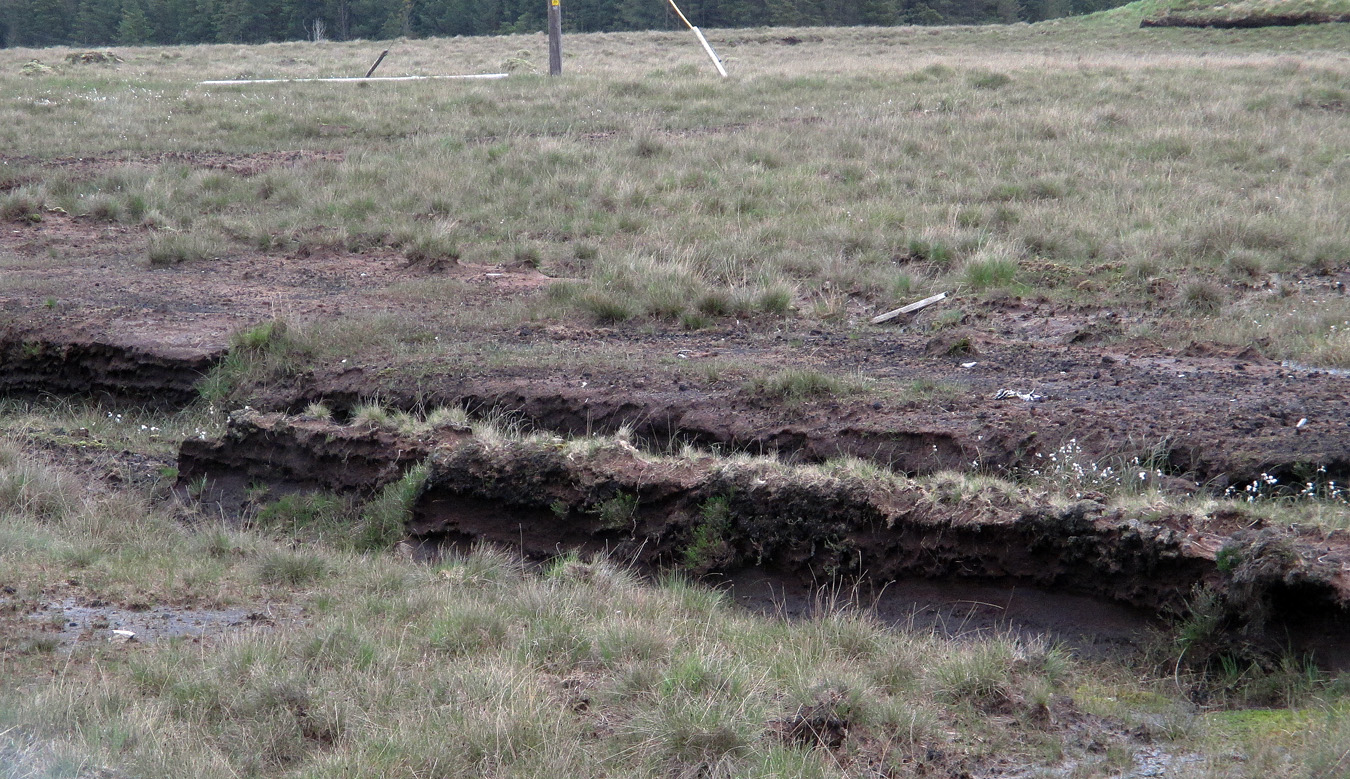 |
| This is a peat bog, and some of the peat, or turf, has been dug up and is ready to be dried |
 |
| And here is peat dried and cut and ready for burning - again, pardon the glare - we were unable to get out and have a look around, so I got this shot through the window. |
Interestingly, and unhappily for many people in Ireland, particularly in rural areas such as Connemara, turf/peat is a fossil fuel, and the European Union is cracking down on its use. As of this writing that issue has not been resolved.
You, dear readers, may have noted that by now Cam was in his element, for other than my addition of theatrical references, most of the above stories came from or at least were initiated by him. Also that while the day has been one of near continuous rural beauty, the only stop we made so far that one could call major was Cong. And at 20-30 minutes, that's not major compared to other trips, which offer two or three. This was fine with me, as it was my last tour, and easier than the last few, as I mentioned above. The big stop was coming up.
 |
| Our "big" stop - Kylemore Abbey in the distance |
In fact let's get to it now. The story of Kylemore Abbey is fascinating, and dramatic enough that I'm surprised no one has made a film version, or maybe a TV mini-series. It began with a very wealthy Britisher, Mitchell Henry, who unlike almost all the other English liked the Irish people. He also liked privacy and discovered, with his new wife Margaret, a beautiful area in Connemara. Both fell in love with it, so he built what is now called Kylemore Abbey not for religious purposes but for her, as a "stately home of England" deposited in rural Ireland. Not an abbey then, but a castle. He employed three hundred Irish and paid and treated them well - unusual to say the least - good for him!
 |
| Here's the abbey closer up |
 |
| And here's one of the views from the property |
To keep a long story brief - not easy for me or Dottore Gianni (and of course we're in this together) - his wife died young, and his daughter not long after. Broken-hearted, he built on the property, which also housed a large formal English garden, a beautiful Neo-Gothic church that some have called a miniature cathedral, to honor her memory. And then he left himself, but not before the King came for a visit in 1903.
 |
| The lovely "cathedral-in-miniature" that Mitchell Henry built in his wife's memory, not far from the castle/abbey, about a ten minute walk, also with views to the lake & mountains |
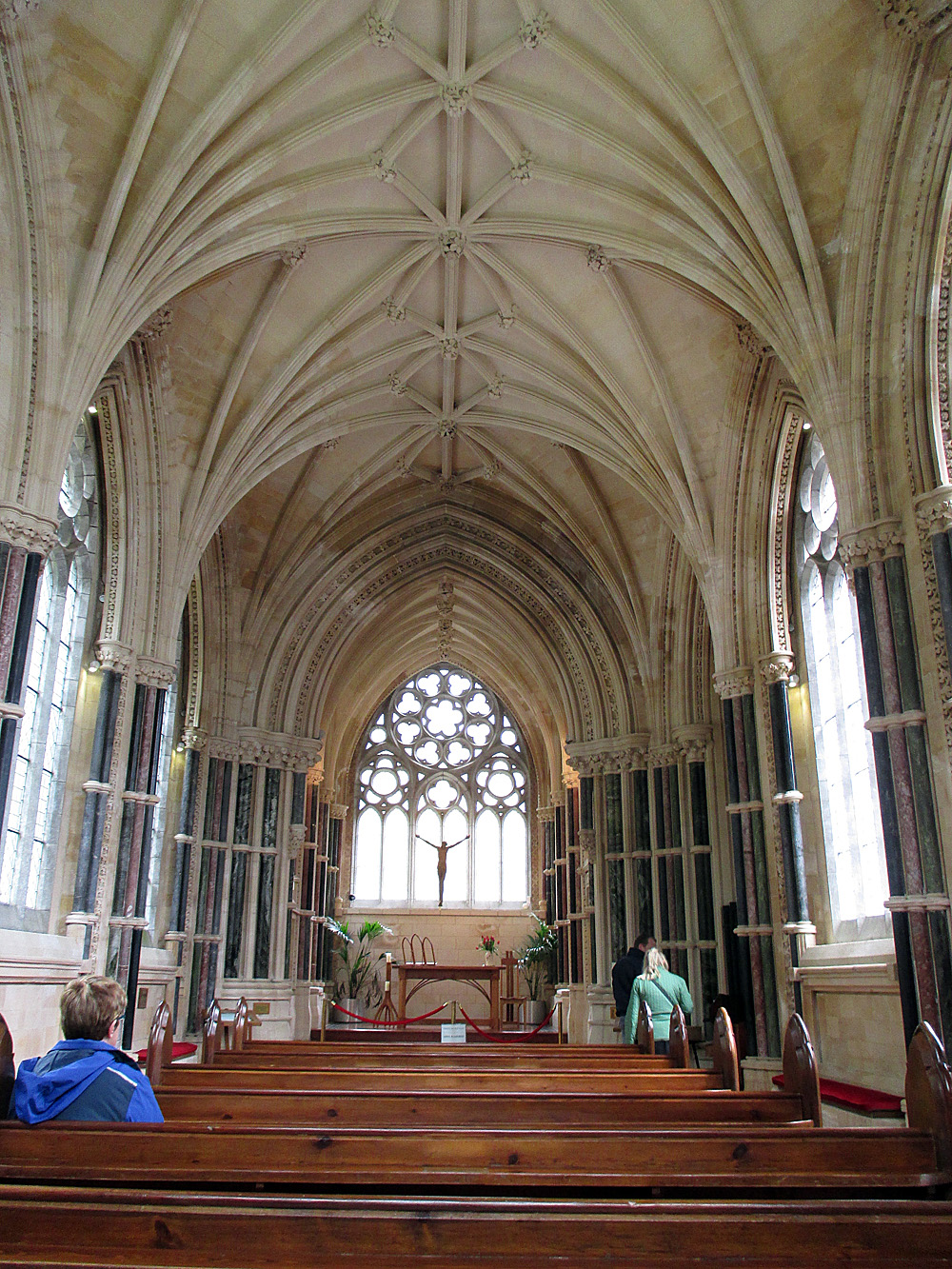 |
| It's a little beauty |
That same year the estate was sold to the profligate Duke and Duchess of Manchester. She was an American heiress whose father subsidized the purchase. Alas, the Duke gambled all his (and her - read Henry James) money away and ultimately the estate too.
 |
| Another dramatic view from the castle grounds |
Cut to World War I, when a group of Belgian Benedictine nuns didn't "climb every mountain" (though there are many to climb around Kylemore heh heh) but did need to get out of that war-torn zone. THEY bought Kylemore after the war, which became an abbey. Also a school, a very posh school in fact, for girls, the daughters of very wealthy men from as far afield as the Middle East and India (the daughter of Maharaja Ranjit studied there). The school closed in 2010, but the nuns still own and run it (along with about 100 employees, a far cry from the 300 who worked it in the early days). The Benedictines allow only three or four rooms to be seen by the public these days, but from what I understand, more will be opened for public view soon.
 |
| A view from the vicinity of the English gardens |
 |
| Part of the formal English gardens |
I had a very quick take-away sandwich at Kylemore, as I wanted to get the most out of the Abbey, the church and the gardens. There is a restaurant there where one can purchase full and fairly expensive meals or a simple sandwich as I had. I found myself with some time to spare and hunted around the nice gift shop, then hopped aboard the bus and off we went.
 |
| A view from our last photo stop |
The tour was nearly but not quite ended, as there was one one last beautiful photo opp stop, where I made the acquaintance of a charming young Spaniard named Alba who was also traveling solo (and who had taken the earlier photo of me. We sat together for the ride back to Galway and chatted constantly. She wants to be a diplomat and I think has the skills to do so. While I am shy in such matters Dottore Gianni is not, and he suggested that she and he/I become Facebook friends - which we are!
 |
| Alba posed in a similar position to the one I'm in at this craggy mountain, so I decided to do the same - glad I did - farewell, Connemara! |
My chat with Alba allowed the time to fly on the drive back to Galway. We here dropped at the coach station, she headed to her sister's place, and I to dinner! Back on my usual stroll this evening, through Eyre Square, into the pedestrian zone, and once there in search of an eatery that looked inviting.
 |
| Back in Galway, the place where I dined |
I found one in the Druid Lane Restaurant on the main pedestrian drag located at, as luck would have it, Druid Lane,
 |
| and my delicious dinner |
Walking back along the pedestrian zone (after purchasing a few souvenirs for my brother Phil, his wife Kara and their son Cam, who take such good care of me here in the Carolinas), I had the great good and serendipitous fortune to stumble on the really good guitarist I heard playing, in the same spot he had been before, between two statues of seated men, one of whom I recognized as Oscar Wilde. I dropped some money into his guitar box and strolled back to my shabby room, after making a quick purchase of another Harp Lager and crisps to get me through my last night in Galway. I miss it.
 |
| The fine guitarist and his captive audience - Oscar and Eduard! |
Sidebar re the statues: This is such an unusual story that I have to let you know about it. In the photo above the statue on the left is, pretty obviously (if you're Dottore Gianni at least) Oscar Wilde. I thought that perhaps the other statue was of his father, or a friend. Instead the statue on the right is of an Estonian writer, Eduard Vilde, a contemporary of Oscar though the two never met. The Estonian woman who sculpted the statue of Wilde as well as Vilde (note the similarity of the names) said that she imagined the year 1890, when the two, "Wilde & Vilde" might have met, and sat, and chatted. A lovely thought. Here's the capper: the statue was a gift to Ireland from Estonia, on the occasion of the latter's admission to the European Union. A perfect gift in my opinion, as the union, albeit imaginary, of two fine writers is a symbol of the EU...or what the EU could and should be.
Sunday 25 May: Thought I was finished, didn't you? Truth to tell there is not enough left to say about the trip to Ireland to merit another post, so I am going to very quickly take you through the next morning in Galway, the train ride back to Dublin, and a bit about my afternoon and evening there, the last day I'd spend in Ireland. Nothing about the 26th, when I flew back - though I'll say that I got to the airport easily and the flights were smooth.
When I returned to my room I was in good spirits, but when I walked into the bathroom I became upset, as whoever cleaned my room, which didn't seem very clean at all, left me
 |
| The torn towel |
I easily got to the Galway Rail Station as it was but a short walk away, and boarded my train in plenty of time. It filled to overflowing, particularly on the stops close to Dublin, and an obnoxious brute sat down next to me, reeking of cigarette smoke and booze. He couldn't seem to stop talking to his friend seated opposite in a loud angry voice, but in an accent so think I couldn't decipher much of it. Didn't care to, in fact.
 |
| My compact but pleasant room at The Townhouse - the area at upper left leads to a tiny balcony looking over a nice courtyard |
In Dublin I hopped on the LUAS tram, which was also jam-packed - it was a Sunday afternoon in the capital and the weather was lovely). I found my new hotel, The Townhouse, very easily, a MUCH better hotel than the one in Galway (wouldn't have been difficult to outdo that one) with very friendly staff - AND it was at one time the residence of Dion Boucicault, one of the great melodramatists of the mid-nineteenth century. There was memorabilia all over the walls. When I saw that I found myself wishing that I'd stayed there on my first two nights in Ireland, rather than Wynn's. Ah well, so what?
I made a dash around an absolutely PACKED Dublin for last minute souvenirs - one for myself that almost makes me long for winter, as it is a dark green hooded sweatshirt with the Trinity College logo on it - delighted with that - and a few last-minute items for my brother and his family.
In fact Dublin was so sadly packed that I made no attempt to engage in any other touristic activity. If that last phrase sounds pretentious, it wasn't my idea - Dottore Gianni insisted I write it that way. I wasn't saddened by the ridiculous crowds, as on my way to souvenir and Dublin hell I noticed two appealing places very near my hotel. The first was The Celt, a pub just around the corner, where I saw a sign that claimed "Traditional Irish Music - 5:30 pm" - those of you (you few, you precious few) who have read all of my posts on Ireland will know that as in most cases "trad" music sessions don't start until 9:30 pm, I had so far attended none, as I was exhausted from my very active...touristic activity...(sorry) at the end of every day, and was nearly in bed by that time. So I was delighted to be able to end my Irish travels with a bit.
I also saw two Italian restaurants on the same street a few blocks down from the pub, so when I returned to the area at about 3:30 pm I chose the better looking of the two named The Italian Connection) and had a very nice Margherita pizza, salad, and glass of red wine at this family run restaurant. I couldn't finish the pie (or did I realize that it could also serve as my evening snack at the Townhouse?) so they wrapped it for me. Then I dropped my shopping bags and the pizza in my room at the hotel, freshened up a bit and strolled to the "trad" music session.
 |
| The delightful bar at the place that advertised "trad" music - if you have a look above the clock, there's a sort of license plate that says "Pog mo Thoin" - it means kiss my arse in Irish! |
When I arrived I found the bar VERY cool-looking, heard a solo musician warming up, and drank a portion of one of the tastiest draughts of Guinness that I'd had in my entire trip. Wonderful, right? But the music was NOT wonderful. The fellow played a song that he had clearly written himself, then one actual traditional Irish dance tune, then a Beatles song (?!?) and finally (for me) invited a young woman up to sing a song SHE had written. This song was woefully bad, but at least it was long. One man I took to be the manager seemed to agree, as he looked to the barman and made a sign as if slitting his own throat. I took it to mean that this was the last chance the featured musician had, and that he'd never play here again. At least I hope that's what he meant. In any case I didn't stick around as the young woman, who by the way got almost no applause, was embarrassingly kept up at the stand while the featured musician kept saying, "Come on, let's hear it for her! You can do better than that!" It seemed that no one wanted to do better than that, but I really couldn't tell, as I was out the door and in the fresh air, which I inhaled deeply, thankful to be free of that bar and those musicians.
 |
| Another look at the bar - note JFK in a place of honor |
I stopped at a grocery to pick up a pint of beer for the evening. I needed to be awake at 5 am, so I called it an early night, drinking my beer, eating my leftover pizza - I love it cold, don't you? And thinking on what was for the most part a quite wonderful two weeks on the Emerald Isle.
And that, in seven separate posts, is much of how Dottore Gianni and I spent our Irish journey. Hope you liked it! Slainte!
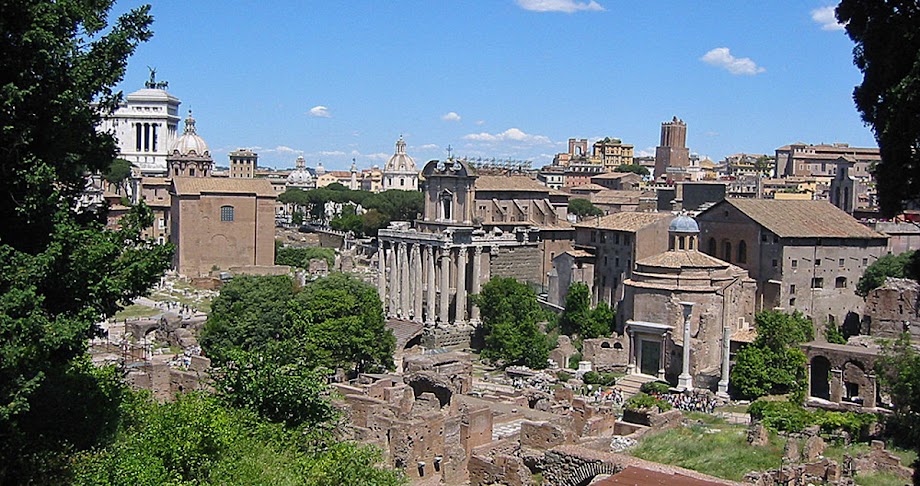















+May+14.jpg)












